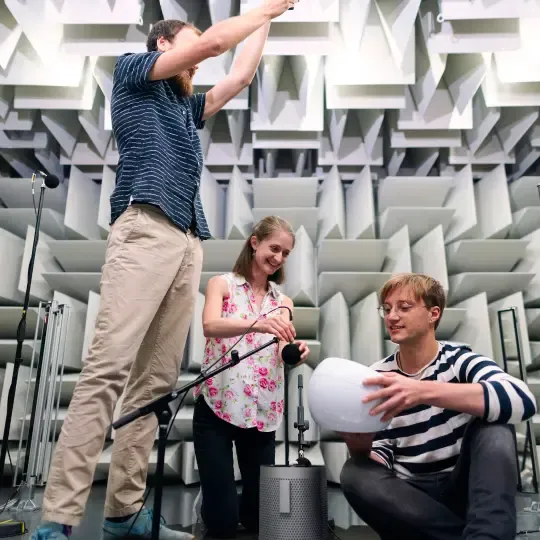
Service Overview
Our acoustic engineering service provides expert solutions for designing and optimising soundproofing systems that deliver precise acoustic control. From reducing noise transfer between rooms to designing acoustically optimised spaces such as recording studios and offices, our expert team ensures that your project meets the highest acoustic standards.
Book Your Consultation
For more information or to schedule an acoustic engineering consultation, please contact us via:
M: +1 609 318 3151
office@decibelinternational.com
What We Do
Our expert engineers assess and calculate the required soundproofing measures based on the noise source and the target acoustic performance. Whether you're working on a soundproofing project for a private home or a large industrial facility, our detailed engineering plans ensure optimal results.
Service Categories
- Soundproofing Projects
For rooms with specific noise control requirements (e.g., reducing speech from 85 dB/A to below 25 dB/A in a neighbouring bedroom), we calculate the sound energy loss through construction materials and determine the layers required to meet the desired insulation level.
- Acoustic Projects
We also design acoustic treatments for spaces like studios, concert halls, shops, and offices. This includes calculating parameters such as reverberation time (RT60/RT30), clarity of speech (D50 and C50), early and late reflections, and the Speech Transmission Index (STI). The projects also incorporate modal and wave analysis to ensure optimal acoustic performance.
For both soundproofing and acoustic projects, we provide detailed technical specifications, 3D visualisations, and quantitative value calculations for the materials and construction required.
Expected Outcomes
With our acoustic engineering services, clients can expect:
- Predictable, measurable results for sound insulation or acoustic treatment based on precise calculations.
- Significant noise reduction or enhanced sound quality in spaces, depending on the project's objective.
- A comprehensive project plan, including technical details, material quantities, and installation steps to achieve the required acoustic standards.
Step-by-Step Process
Our acoustic engineering service follows a structured process to ensure the best results:
- Initial Consultation: We begin with a discussion to understand your acoustic needs and project goals.
- Site Analysis: Our engineers assess the space, its construction, and noise levels to gather necessary data.
- Project Design: Using specialised software, we model the acoustic environment and propose soundproofing or acoustic treatments based on calculated parameters.
- Solution Presentation: A detailed project plan, including technical drawings and material requirements, is provided for review.
- Implementation Support: We offer ongoing support during the implementation phase to ensure that the project is executed according to the plan.
Technology & Tools
To ensure the precision of our acoustic engineering designs, we rely on advanced tools and methodologies:
- Engineering approach
We define the key parameters—sound sources, transmission paths, and receiver points—ensuring we comprehensively understand the acoustical environment to design an effective solution.
- Frequency spectrum analyser
This tool is used to break down and measure the sound across various frequencies, helping us identify problematic frequency ranges that need treatment.
- Accelerometer/Vibrometer
Essential for measuring vibration in structures and equipment. These devices help assess how vibrations are transmitted through surfaces and materials, guiding our designs for vibration control.
- Sound source imaging camera
A cutting-edge tool that visually represents how sound waves travel through a space, allowing us to identify and focus on the most problematic areas during the acoustic design process.
- Intensimeter
Used to measure sound intensity at various locations within a space, enabling us to determine how sound energy is distributed and absorbed, which is crucial for effective acoustic treatments.
Compliance & Standards
All our acoustic engineering projects comply with the most stringent international standards for sound measurement and control, ensuring that results meet both functional and regulatory requirements:
- ISO 16283-1: Acoustics – Field measurement of sound insulation in buildings and of building elements. This standard guides us in accurately assessing airborne sound insulation between rooms.
- ISO 717-1: Rating of sound insulation in buildings and of building elements – Part 1: Airborne sound insulation. This is used to evaluate sound reduction across different building components.
- ISO 3741: Acoustics – Determination of sound power levels of noise sources using sound pressure. It provides guidance for determining sound power levels in a controlled environment, which helps in diagnosing noise levels from machinery and equipment.
- ISO 9613-1: Acoustics – Attenuation of sound during propagation outdoors. This international standard is essential when calculating how sound behaves in external environments, which is critical for industrial and outdoor projects.
Selected Case Studies
Our acoustic engineering projects have helped clients across various sectors achieve optimal sound environments. A few examples include:
Acoustic Enhancement for ETEM Showrooms
Acoustic Panels Installation in a Famous Radio Studio
Soundproofing Enclosure in Manufacturing Facility
Book Your Consultation
For more information or to schedule an acoustic engineering consultation, please contact us via:
M: +1 609 318 3151
office@decibelinternational.com